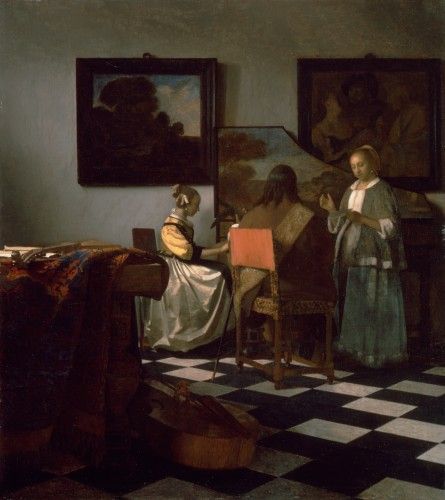Sophie Calle: Last Seen at Isabella Stewart Gardner Museum, Boston
Sophie Calle, What Do You See? (Vermeer, The Concert), (detail), 2013. ©2013 Sophie Calle / Artists Rights Society (ARS), New York / ADAGP, Paris. Courtesy of Sophie Calle, Paula Cooper Gallery, New York, and Isabella Stewart Gardner Museum, Boston.
BOSTON- Sophie Calle: Last Seen will include Calle’s 1991 Gardner-inspired work on display for the first time at the Gardner, as well as new work created in 2012.
The 14 photographic and text based works in Last Seen consist of two distinct series. The first, created in 1991, titled Last Seen… is a series of photographs and texts created shortly after the 1990 theft during which 13 objects were stolen from the Museum. The second series, titled What Do You See?, includes new work which Calle made in 2012 at the Museum while revisiting the earlier project.
In 1990, during an exhibition of Calle’s work at the Institute of Contemporary Art, Boston, Calle was interviewed for a Parkett magazine article by Sheena Wagstaff. At Calle’s request the interview took place at the Gardner in front of Jan Vermeer’s 1658–60 painting The Concert, one of Calle’s favorite paintings. Later that March, the painting became one of the thirteen works stolen from the Museum. Wagstaff later hinted that perhaps Calle was responsible for the theft. This suggestion spurred Calle to consider creating a project focused on the Gardner’s stolen works.
While standing in front of the empty spaces on the Museum walls where works were once hung, Calle asked curators, guards, conservators, and other Museum staff members what they remembered of the missing pieces. Calle used text from the interviews and the photographic images to create a visual meditation on absence and memory, as well as reflection on the emotional power works of art hold on their viewers.
In 2012, the Gardner invited Calle to revisit her Last Seen… project, which had never been viewed in Boston. Since Calle’s 1991 work in the Museum, the empty frames that once held the absent works had been reinstalled in the galleries, literally framing the emptiness.
In creating her new project, What Do You See?, Calle once again questioned people in the Museum’s Dutch Room, but this time she did not mention the missing paintings to the staff and visitors with whom she spoke. She asked each viewer to respond to what they saw before them.
Last Seen… was first shown at the Carnegie International in Pittsburgh in 1991. Since then, it has been presented, in its entirety or in abridged form, at the Leo Castelli Gallery, New York; the Museum of Modern Art, New York; Dartmouth College’s Hood Museum in Hanover, New Hampshire; Boijmans Van Beuningen, Rotterdam; the Musée Cantonal des Beaux-Arts, Lausanne; the Galerie Chantal Crousel, Paris; and the Portalen, Koge Bugt Kulturhus, Copenhagen. Last Seen… was also featured as part of a Calle survey show organized in 2003 by the Centre Pompidou in Paris, which traveled to the Ludwig Forum für Internationale Kunst, Aachen; the Martin Gropius Bau, Berlin; and the Irish Museum of Modern Art, Dublin.
Johannes Vermeer (Dutch, 1632-1675), The Concert, about 1665. Oil on canvas, 72.5 x 64.7 cm. P21w27. The Isabella Stewart Gardner Museum, Boston © 2013 Isabella Stewart Gardner Museum
In a pristine domestic parlor, two women and a man concentrate on making music. The standing woman holds a sheet of music and raises her hand to beat time for her companions. Turned enigmatically away from our gaze, the seated gentleman wears an elaborate decorated sash that indicates his membership in a civic militia. Some scholars have been tempted to interpret Dutch musical scenes like this as moral warnings against seduction and illicit sex. Indeed, hanging on the wall at the right is a painting of a procuress by Dirck van Baburen. Although the subject of this painting-within-a-painting seems to suggest that something improper is taking place, the Procuress was in fact owned by Vermeer’s family. Moreover, the figures in the room are intently preoccupied with their music: they do not look at each other, and seem unaware they are being observed. Their intensity does not invite interruption. Lying on the large table at left is a lute, while a viola da gamba lies on the floor. Are these instruments soon to be taken up by the trio, or are others to join the group? Vermeer crafts rather deliberately a sense of mystery: this study in social interaction is a comedy of manners open to our interpretation.
The mystery is intensified by Vermeer’s famed attention to the reflections of light. It sparkles off the women’s pearls (Mrs. Gardner’s favorite), the gold threads of the man’s sash, the white silk skirt, and even the Persian carpet heaped on the table.
Isabella Stewart Gardner may have been drawn to the painting by its elegant depiction of the domestic music-making that she herself was so fond of. The painting was her first major acquisition, and she bought it without the help of experts. It was bought at the Paris auction of the estate of Théophile Thoré (1807–1869), a prominent critic who wrote under the pseudonym William Bürger. He had been instrumental in reviving the reputation of Vermeer, which made this painting especially important.
Source: Alan Chong, "The Concert," in Eye of the Beholder, edited by Alan Chong et al. (Boston: ISGM and Beacon Press, 2003): 149.

/https%3A%2F%2Fprofilepics.canalblog.com%2Fprofilepics%2F1%2F0%2F100183.jpg)
/https%3A%2F%2Fstorage.canalblog.com%2F03%2F02%2F119589%2F96711876_o.jpg)
/https%3A%2F%2Fstorage.canalblog.com%2F11%2F31%2F119589%2F94773502_o.jpg)
/https%3A%2F%2Fstorage.canalblog.com%2F20%2F83%2F119589%2F94772815_o.jpg)
/https%3A%2F%2Fstorage.canalblog.com%2F26%2F72%2F119589%2F75604929_o.jpg)
/https%3A%2F%2Fstorage.canalblog.com%2F59%2F60%2F119589%2F26458628_o.jpg)




/http%3A%2F%2Fstorage.canalblog.com%2F22%2F87%2F119589%2F32110696_o.jpg)
/http%3A%2F%2Fstorage.canalblog.com%2F84%2F73%2F119589%2F128782095_o.jpeg)
/http%3A%2F%2Fstorage.canalblog.com%2F68%2F37%2F119589%2F128313729_o.jpg)
/http%3A%2F%2Fstorage.canalblog.com%2F19%2F23%2F119589%2F128179837_o.jpg)